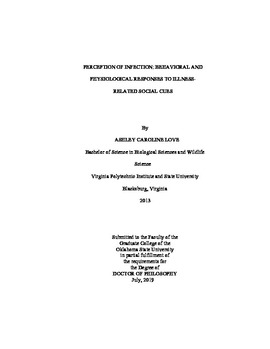| dc.contributor.advisor | DuRant, Sarah | |
| dc.contributor.author | Love, Ashley Caroline | |
| dc.date.accessioned | 2020-01-30T15:03:10Z | |
| dc.date.available | 2020-01-30T15:03:10Z | |
| dc.date.issued | 2019-07 | |
| dc.identifier.uri | https://hdl.handle.net/11244/323359 | |
| dc.description.abstract | Individuals vary in how they respond to and transmit infection. Both pre- and post-infection shifts in behavior, diet, and physiology can contribute to variation in disease susceptibility and disease transmission potential. However, little is known about how social information about infection risk shapes individual-level characteristics that contribute to the spread of disease through vertebrate populations. Animals can detect and respond to sick individuals, most commonly through avoidance behaviors that reduce the risk of infection. While the social effects of infection are rarely explored outside the context of avoidance behaviors, social information about disease could have prominent effects on reproductive and social behaviors, as organisms must weigh the benefit of engaging in social interactions with the risk of becoming sick. Work in humans and insects suggests that organisms are also capable of mounting immune responses to visual cues indicative of heightened infection risk, however, the effects of visual social cues on immune responses are not well understood. My dissertation work was focused on understanding the strategies that social vertebrates use to respond to and prepare for infection by investigating how infection and visual cues of disease alter behavioral, nutritional, and physiological responses relevant to disease susceptibility and transmission in songbirds. Birds make an excellent model for addressing questions about visual cues of disease because they are social animals that rely primarily on vision for detecting immune threats and carry diseases relevant to wildlife, domestic animal, and human health. The work in this dissertation emphasizes that social context and social cues indicative of heightened infection risk can influence behavioral and physiological responses relevant to disease susceptibility and transmission. In addition, my work indicates that birds have diverse, and likely integrative, behavioral, physiological, and nutritional strategies to respond to and prevent infection. | |
| dc.format | application/pdf | |
| dc.language | en_US | |
| dc.rights | Copyright is held by the author who has granted the Oklahoma State University Library the non-exclusive right to share this material in its institutional repository. Contact Digital Library Services at lib-dls@okstate.edu or 405-744-9161 for the permission policy on the use, reproduction or distribution of this material. | |
| dc.title | Perception of Infection: Behavioral and Physiological Responses to Illness-Related Social Cues | |
| dc.contributor.committeeMember | Grindstaff, Jennifer | |
| dc.contributor.committeeMember | Lovern, Matthew | |
| dc.contributor.committeeMember | Lutter, Erika | |
| osu.filename | Love_okstate_0664D_16353.pdf | |
| osu.accesstype | Open Access | |
| dc.type.genre | Dissertation | |
| dc.type.material | Text | |
| dc.subject.keywords | avoidance behavior | |
| dc.subject.keywords | immunology | |
| dc.subject.keywords | macronutrients | |
| dc.subject.keywords | nutrition | |
| dc.subject.keywords | sickness behavior | |
| dc.subject.keywords | visual cues of infection | |
| thesis.degree.discipline | Integrative Biology | |
| thesis.degree.grantor | Oklahoma State University | |
